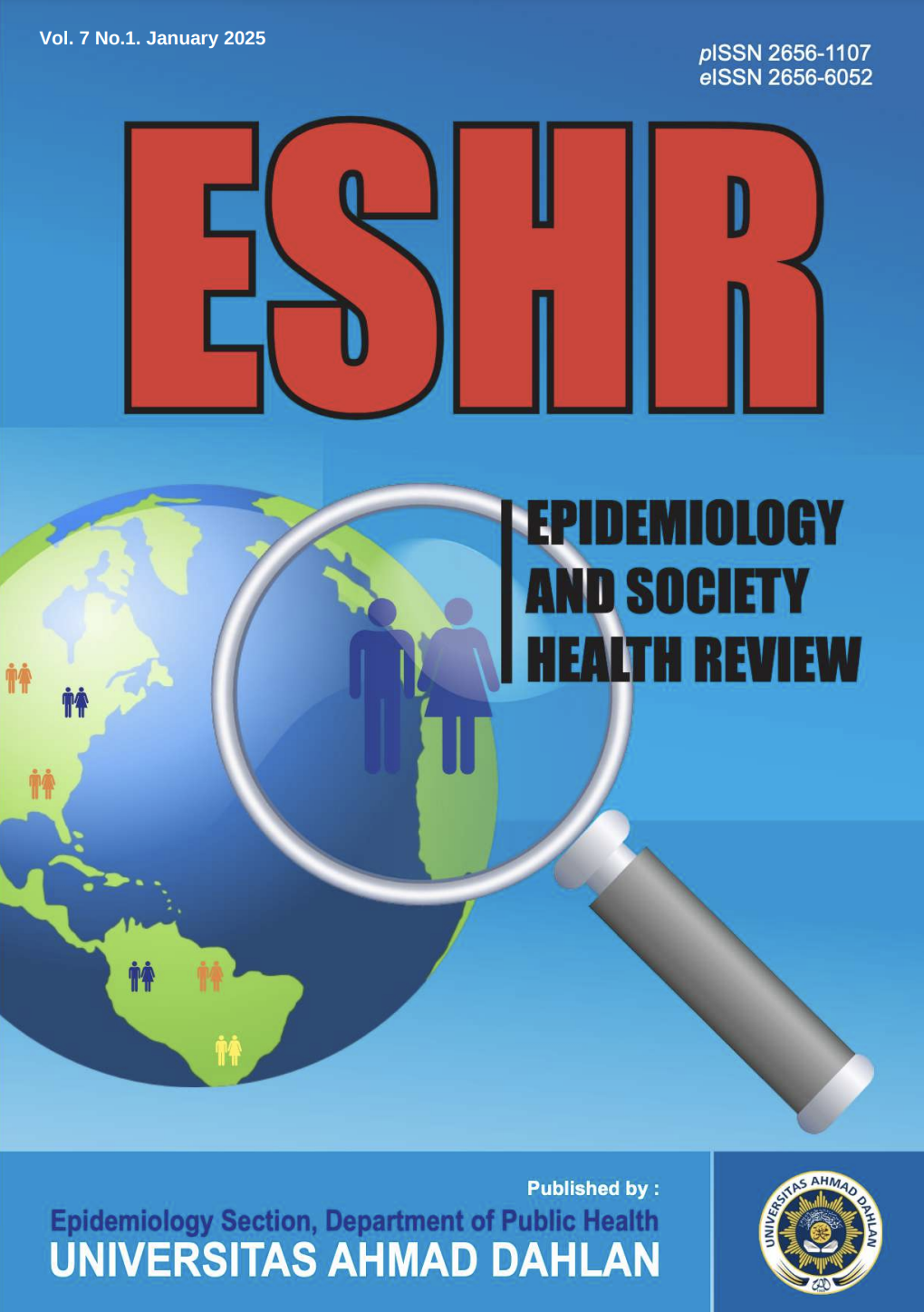Exclusive Breastfeeding as a Risk Factor for Stunting Among Under-Fives in Urban and Rural Indonesia: A Systematic Review
DOI:
https://doi.org/10.26555/eshr.v7i1.12565Keywords:
Stunting, Risk Factors, Exclusive BreastfeedingAbstract
Background: Previous research found that children in rural areas have a 1.3 times greater risk of stunting than children in urban areas. Exclusive breastfeeding is one of the risk factors for stunting. The 2017 Indonesian Demographic and Health Survey (IDHS) showed that the percentage of exclusive breastfeeding in urban areas was 37.8%, while in rural areas, it was 46.9%. The purpose of this study was to determine the magnitude of the risk of stunting in toddlers who are not exclusively breastfed in rural and urban areas.
Method: This research used a Meta-Analysis Systematic Review by searching articles in PubMed, Google Scholar, and Garuda that were in Indonesian or English and published between 2019 and 2024. Keywords included stunting, risk factors, exclusive breastfeeding, children under five, rural, and urban. The article search used the PICO framework, while the article quality assessment used the Joanna Bright Institute (JBI) Critical Appraisal Instrument. The data collected was presented in a PRISMA diagram and analyzed based on Forest Plot graphs using RevMan 5.4.1.
Results: A total of 3,269 articles were identified, and 11 met the criteria. The analysis showed that toddlers not exclusively breastfed had a 3.84 times greater risk of stunting in rural areas and 2.38 times greater for urban regions than exclusively breastfed toddlers.
Conclusion: Children who are not exclusively breastfed in rural areas are at greater risk of stunting than those in urban areas.
References
Agustina SA& Rahmadhena MP. Analysis of Determinants of Toddler Nutritional Problems. Journal of Health. 2020;7(2):353–60. https://doi.org/10.35730/jk.v11i1.685 /
WHO. World Health Organization (WHO). Nutrition Landscape Information System (NLIS).2021.
UNICEF, WHO, WORLD BANK. Levels and Trends in Child Malnutrition. 2023:4.
Ministry of Health of the Republic of Indonesia. Stunting in Indonesia and Determinant Factors. In: SKI Thematic Report 2023. 2023.
FAO, IFAD, UNICEF, WEP, WHO. Urbanization, Agrifood Systems Transformation and Healthy Diets Across the Rural-Urban Continuum. In: The State of Food Security and Nutrition in the World 2023. Rome. 2023:1–316.
Basic Health Research (BHR). Balitbangkes Publishing Institute. 2018:1–627.
Indonesia Ministry of Health. Indonesian Health Survey (SKI) in Figures. Ministry of Health of the Republic of Indonesia. Central Jakarta. 2023:1–964.
WHO. Childhood Stunting: Context, Causes and Consequences WHO Conceptual framework. 2013.
WHO. Childhood Stunting: Context, Causes, and Consequences. World Health Organization (WHO). 2019:4.
Savita R& Amelia F. The relationship of maternal employment, gender, and exclusive breastfeeding with the incidence of stunting in toddlers aged 6-59 months in South Bangka. Journal of Health Polytechnic of the Ministry of Health of the Republic of Indonesia Pangkalpinang. 2020;8(1):1. https://doi.org/10.32922/jkp.v8i1.92
Pratama FI, Mayulu N, & Kawengian SES. The Relationship between Exclusive Breast Milk (ASI) and Stunting Incidence in Toddlers in Manado City. e-Biomedic Journal (eBm). 2019;7(2):156–60. https://doi.org/10.35790/ebm.v7i2.26873
Indonesia Ministry of Health. The 2022 Indonesian Nutritional Status Survey (SSGI). In: Ministry of Health. 2022:1–150.
Pratama MR & Irwandi S. The Relationship Between Exclusive Breastfeeding and Stunting at Hinai Kiri Health Center, Secanggang District, Langkat Regency. STM Medical Journal (Science and Medical Technology). 2021;4(1):17–25. https://doi.org/10.30743/stm.v4i1.65
Suryani L. The Relationship between Exclusive Breastfeeding and the Incidence of Stunting in Toddlers in the Limapuluh Kota Pekanbaru Health Center Work Area. Midwifery Update Journal (MU). 2021;3(2):126. https://doi.org/10.32807/jmu.v3i2.120
Suwartini I, Hati FS, & Paramashanti BA. History of Exclusive Breastfeeding and Stunting in Children Aged 24-59 Months in Pajangan and Pleret Districts, Bantul Regency. Journal of Food Nutrition Media. 2020;27(2):37–43. https://doi.org/10.32382/mgp.v27i2.1642
Lestari ED, Hasanah F,& Nugroho NA. Correlation between non-exclusive breastfeeding and low birth weight to stunting in children. Paediatrica Indonesiana. 2018;58(3):123–7.
Ministry of Village Regional Development Disadvantaged and Transmigration. Village pocketbook in handling stunting. 2017:42. https://doi.org/10.14238/pi58.3.2018.123-7
WHO. World Health Organization (WHO). Mums Need More Breastfeeding Support During Critical Newborn Period.2024.
Ministry of Health Republic of Indonesia (Ministry of Health of the Republic of Indonesia). Regulation of the Minister of Health of the Republic of Indonesia Number 15 of 2014. 2014:1–13.
Hajifah T, Kesumadewi T, Kunci K, Hangat K, & Tubuh S. Implementation of Health Education on Exclusive Breastfeeding to Improve Knowledge of Breastfeeding Mothers at Purwosari Health Center. Jurnal Cendikia Muda. 2022;2(September):423–8.
Astriana W & Afriani B. Weight Gain in Infants Aged 0-6 Months Reviewed from Breastfeeding. Jurnal 'Aisyiyah Medika. 2022:128–36. https://doi.org/10.0.143.121/jam.v7i2.860
Akram, R., Sultana, M., Ali, N., Sheikh, N., & Sarker, AR. Prevalence and Determinants of Stunting Among Preschool Children and Its Urban-Rural Disparities in Bangladesh. Food and Nutrition Bulletin. 2018;39(4):521–535. https://doi.org/10.1177/0379572118794770
Kalinda, C., Phiri, M., Simona, S.J., Banda, A., Wong, R., Qambayot, MA, Ishimwe, SMC, Amberbir, A., Abebe, B., Gebremariam, A., & Nyerere, JO. Understanding factors associated with rural-urban disparities of stunting among under-five children in Rwanda: A decomposition analysis approach. Maternal and Child Nutrition. 2023;19(3). https://doi.org/10.1111/mcn.13511
Tadesse, SE, Mekonnen, TC, Dewau, R., Zerga, AA, Kebede, N., Feleke, YW, & Muche, A. Urban-rural disparities in stunting among Ethiopian children aged 6–59 months old: A multivariate decomposition analysis of 2019 Mini-EDHS. PLOS ONE. 2023;18(4 April):1–10. https://doi.org/10.1371/journal.pone.0284382
Grind, VGT, Uy, J., & Casas, LD. What explains the large disparity in child stunting in the Philippines? A decomposition analysis. Public Health Nutrition. 2022; 25(11):2995–3007. https://doi.org/10.1017/S136898002100416X
Widyaningsih, V., Mulyaningsih, T., Rahmawati, FN, & Adhitya, D. Determinants of Socio-Economic and rural-urban disparities in stunting: evidence from Indonesia. Rural Remote Health. 2022; 22(1):7082. https://doi.org/10.22605/RRH7082
Palupi FH, Renowening Y, & Mahmudah H. Mother's Knowledge About Nutrition Is Related to the Incidence of Stunting in Toddlers Aged 24-36 Months. Mahardika Health Journal. 2023;10(1):1–6. https://doi.org/10.54867/jkm.v10i1.145
Wahyuni D. Socio-economic influences on stunting incidence in Kulau Mining Village, Kampar. Preportif: Journal of Public Health. 2020;4(1):25. https://doi.org/10.31004/prepotif.v4i1.539
Tebi, Dahlia, Wello EA, Safei I, Rahmawati & Juniarty S. Literature Review of Factors Affecting Stunting in Toddlers. Fakumi Medical Journal: Journal of Medical Students. 2022;1(3):234–40.
Noorhasanah E & Tauhidah NI. The Relationship between Mother's Parenting Patterns and the Incidence of Stunting in Children Aged 12-59 Months. Journal of Pediatric Nursing. 2021;4(1):37–42. https://doi.org/10.32584/jika.v4i1.959
Solikhah LS, Huraera WR, & Imansari A. The Relationship between Mother's Characteristics, Services and Facilities of Integrated Health Posts (Posyandu) with the Participation of Toddler Mothers to Integrated Health Posts (Posyandu) in the Working Area of Kinovaro Health Center. Ghidza: Journal of Nutrition and Health. 2023;7(2):216–226. https://doi.org/10.22487/ghidza.v7i2.1000
Downloads
Published
Issue
Section
License
Copyright (c) 2025 Rena Anjeli Wibowo, Asep Rustiawan

This work is licensed under a Creative Commons Attribution-ShareAlike 4.0 International License.
Authors who publish with ESHR agree to the following terms:
- Authors retain copyright and grant the journal right of first publication with the work simultaneously licensed under a Creative Commons Attribution License (CC BY-SA 4.0) that allows others to share the work with an acknowledgment of the work's authorship and initial publication in this journal.
- Authors are able to enter into separate, additional contractual arrangements for the non-exclusive distribution of the journal's published version of the work (e.g., post it to an institutional repository or publish it in a book), with an acknowledgment of its initial publication in this journal.
- Authors are permitted and encouraged to post their work online (e.g., in institutional repositories or on their website) prior to and during the submission process, as it can lead to productive exchanges, as well as earlier and greater citation of published work.












